|
Dutch
Barn Preservation Society
Dedicated
to the Study and Preservation
of New World Dutch Barns
NEWSLETTER,
SPRING 1999, Vol. 12, Issue 1, part two
The Restoration
and Reconstruction of the John J. Post Aisled Dutch Barn, 1997-1998,
continued.
The new site would have to be graded, trees felled and stumps
pulled, 16 concrete piers excavated and poured, and a fieldstone
foundation and retaIning wall built. We needed to prepare timbers
for and join four new main posts, eight side wall posts eight side
wall ties, two side wall plates, two purlin plates, new side wall,
cross and main sills and threshing floor joists, four wagon door
posts and all the miscellaneous studding. The rafter poles had
to be peeled, adzed flat and joined. And that was the easy part.
Remember please that all that was left of the purlin plate was
a seven foot section that gave us the location of two sway braces
and two post mortIses, and that we had the ruined carcasses of
the four interior bent columns, to be replaced by columns of comparable,
but not exact, original size, and that all the other purlin braces
had to be made and joined to the new (scarfed) plates. It is sufficient
to say that on raising day the new plates fit the new braces exactly,
as they must, and that all praise is due to Paul Hofle's intellectual
and manual abilities, as he not only plotted the Pythagorean course,
but Joined the braces and timbers as well.
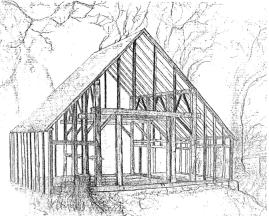 Drawing
of the John J. Post Dutch barn showing structural mambers. Drawing
by Debra Fiacco. Drawing
of the John J. Post Dutch barn showing structural mambers. Drawing
by Debra Fiacco.
The four remaining posts had only marginally survived the culling
that eliminated their brothers, Large sections were excavated and
repaIred with joined repair pieces and epoxy fillers. Repaired
areas were veneered with 3" thick slices of hewn surface.
New post bases were fabricated from sound old stock and joined,
epoxied and bolted to the old fabric. Stainless steel bolts were
bunged with hewn oak rounds The anchor beams were better, two of
the four requiring major work. Bent 2 (from the South) needed a
7 foot section scarfed on, epoxied and through-bolted as well Number
4, North, is about 85 % laminated plywood, joined oak pieces, stainless
steel and veneer. Everything, when done, was soaked in Boracare,
a nontoxic (to humans and animals) boron based insecticide, that
is especially effective on post beetles and carpenter ants.
Jeremiah and B.J., apprentice saints and joiners, spent their
seven months lifting several tons of oak, pine, poplar, granite,
sandstone, dIrt, basalt and concrete, splitting out and shaving
about 500 feet of black locust trunnels, cutting joints (sometImes
the same one three or four times ), mixing several gallons of epoxy,
raising frames and nailing on eighteen hundred board feet of pine
siding and thousands of cedar shakes. New sawn white oak, purchased
oversize, was broad axed or adzed to dimensIon by these two also.
After six weeks of repair, restoration and new work, the frame
members were transported by pickup truck and trailer to the site
in Congers, New York, (village of Clarkstown). The high point of
that journey beIng the four thirty-foot plates carried on the truck's
rack. The white oak and pressure treated SIlls were placed on the
stone foundation walls and bolted to theIr piers. Pipe scaffolding
was erected and bound with chain to the sills, We then rigged timbers
atop the scaffolding and raised the four bents wIth "come
alongs" and muscle. The bents raised and temporarily supported,
we placed the sway braces, tied them up with line, and dropped
the purlin plates in place, and with some very minor adjusting,
they were fastened off with new locust pins.
The side walls and their plates, posts and studs were raised,
ties installed, and diagonal braces let in. The 22 rafters were
lifted into place, after being joined on the ground. Skip sheathing,
free edged, was stripped of bark, cut to length and installed.
The 1 "x12" eastern white pine planking was installed
with 1 0 penny cut nails, and the 24"
red cedar hand split shakes were nailed on by hand, 33 squares
in all. It sounds so easy. The procedures described above took
seven weeks, and we often saw the sun rise and set at the damn
barn.
With the building raised, roofed and sheathed, we began the construction
of the four wagon and four aisle doors, beaded and clench nailed
with wrought strap hinges, the four south wagon door hinges being
original and the rest salvaged from area barns and vetted for date.
We took our tulip-poplar boles to Matt Beckerle's band saw mill,
where he cut our threshing floor planks for next to nothing as
a contribution to the cause. One of these trees belonged to a Mr.
Kellog, who had planted it himself 45 years ago, to have it blown
down in a May windstorm. The tulip poplars hereabouts are often
60 feet or more to the first branch and 3 to 4 feet in diameter,
yielding clear wood in 18 to 25 foot planks. The Wortendyke (Dutch)
barn in Pascack (now Park Ridge), New jersey is framed completely
in this material, as are most of our Dutch houses' exposed joists.
The barn was finished in October, six months after we started
collecting materials. We trained two apprentices and introduced
about 30 people to the traditional methods of wood working and
framing, learned much that was new about the restoration and preservation
of old material, and raised a Dutch barn in Rockland County for
the first time in nearly two hundred years. There were times when
the only sounds at the homestead were of broadaxes and chisels
and birds, and the voices of the joiners. When one stands inside
the barn now, on a sunny day, doors shut, the light emanates from
the seams and vents and illuminates the interior with rays and
beams and sprays of light. The main timbers, washed and cared for,
glow, and their tree-like structure of braces and plates is wonderfully
explicit. The visitor stands on an expanse of wide aromatic planks,
gazing up at the astonishingly complex patterns of rafters, sheathing
and shakes. It was worth all the effort. The John J. Post barn
and the Schueler/Paul house will be open in June 1999.
Foot notes and bibliography
1. Van Tienhoven Purchase, June 15, 1696 Calendar
of New York Colonial Manuscripts, Indorsed Land Papers in the Office
of the Secretary of State of New York 1643 1803, 11, 222.
2. A History of the Post-Sterbenz Land, Hugh Goodman.,
pgs.1-9 Letter from Greg Huber "Post-Sterbenz True Form
Dutch Barn".
George Turrell, a former trustee of the DBPS,
is the Proprietor of AchterCol, a historic restoration firm
in Piermont, New York. Since 1986, AchterCol has restored historic
buildings and artifacts, concentrating on Dutch-American barns
and houses.
The JJ.Post barn restoration was (3/18/99)
awarded the Historical Society of Rockland's 1999 Preservation/Restoration
Category Citation.
The Technical Description:
A
four-bent, three-bay aisled Dutch barn, 36 feet x 30
feet (width by length), side walls of 9 1/2 feet east
and 10 feet west, peak of 24 feet, nave of 18 feet width,
single transverse aisle ties, anchor beams of 12" x
1.0 1/2" with 6" to 8"
wedge less tenon extensions, anchor beam mortise square
shouldered, anchor beam scribe marks at 2% verdiepinghs
at 48" above anchor beam, anchor beams of white oak
(3) and red oak (1) main columns of 9" x 7" X
16' 6". The barn is without raising holes or manger
dadoes, with the longitudinal struts let in on threshing
floor side (east) and aisle side (west) primarily of white
oak with one chestnut and One red oak. Purl in plates of
6" x 5"
hewn oak, 30 feet in length, side wall plates ditto, sawn
purlin and anchor beam braces, no marriage marks except
at purlin braces. Side walls had no diagonal bracing, except
at the comer posts where let-in dovetail braces ran from
post to plate. Hewn surfaces were broad-axed to finish
size, rafters adzed flat on one side, except at gable ends
where two sides were flattened, Rafters were hewn poles
of white ash, tulip poplar, white oak and red oak, joined
with a trunneled, lapped joint. Trunnels of white oak,
1" diameter, 11/2" diameter at anchor beam/post
connection One section of a manger base was extant, used
as an aIsle tie. As Greg Huber points out In hIs report
on the barn, the mixture of techniques and procedures observed
above led him to place its construction In the first part
of the nineteenth century, The county tax records of 1812
confirms this, as the barn was listed as a ratable of John
J. Post. |
Dutch Barn or Not?
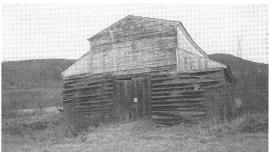 The
Dutch Barn Preservation Society continues to search for articles
to feature in the newsletter. If you have an article or would like
to write an article regarding Dutch barns or houses please contact
the editor. The barn above is the Crounse-Van Aernum Dutch barn
in Guilderland, Albany County, New York. The roof was replaced
in 1959 after a wind storm blew off the original. Photo courtesy
of Chris Albright. The
Dutch Barn Preservation Society continues to search for articles
to feature in the newsletter. If you have an article or would like
to write an article regarding Dutch barns or houses please contact
the editor. The barn above is the Crounse-Van Aernum Dutch barn
in Guilderland, Albany County, New York. The roof was replaced
in 1959 after a wind storm blew off the original. Photo courtesy
of Chris Albright.
The Wortendyke Barn Museum
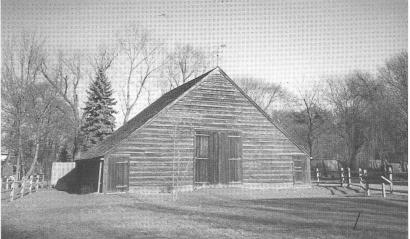
A recent picture of the Wortendyke barn. Notice
the very low side walls. All photos by Robert L. Cohen.
By Robert L. Cohen, Curator, Wortendyke Barn Museum
The Wortendyke New World Dutch Barn is located in the lower Hudson
Valley approximately five miles south of Tappan, New York and approximately
seven miles north of Hackensack, New Jersey. It is also about five
miles west of the Hudson River in northeastern Bergen County which,
at the time of the Revolutionary War, extended from the Hudson
River all the way to Sussex County in the west. Bergen County included
present day Bergen, Hudson, Passaic, and part of Essex Counties.
In those early days of what I'll refer to as the "Hackensack
Valley", Bergen was primarily a farming area that was settled
in the mid to late 1600's by mostly Dutch with some German, French
Huguenot, and a mixture of other European stock. The Dutch were
the largest landowners in Bergen County and their farming activities
spread along the Hackensack and Passaic Rivers in northern New
jersey and to the Raritan and Millstone Rivers in central New jersey.
Remember, before 1664 the entire region from west of the Connecticut
River to the Delaware River and including the Hudson, Mohawk and
Schoharie River Valleys (in present day New York State) were part
of New Netherlands and controlled by the Dutch West India Company.
Boundaries between Colonies really were non-existent until the
late seventeenth to late-middle eighteenth centuries. The population
of the entire state of New jersey in 1745, just before the Wortendyke
Barn was built, was estimated at 61,000. Bergen County probably
had about 67,000 inhabitants in 1770.
Bergen County in the 1770's could be described as having "rich
and broad farmlands...abundantly watered (and) populated by prosperous
farmers descended from the original settlers of New Netherland.
From all accounts, the Hackensack Valley was delightful and prized
farm country with handsome houses, active mills and barns and yards
brimming with livestock and grain." Most of the people living
in the Hackensack Valley at the time the Wortendyke was raised
(circa 1770) were independent farmers owning farmland from 75 acres
to the hundreds of acres. People of Dutch ancestry were numerous
in the Hackensack Valley. They doggedly spoke Dutch in their homes
and churches and kept their Old World customs even though Holland
surrendered New Netherland to the English a century prior to the
American Revolution. "The Dutch were among the largest landowners
in Bergen County..."
Records show Frederick Wortendyke, Sr. having moved from New
York City to Tappan and then to the Hackensack Valley where he
purchased some 465 acres of fertile farmland from Hendrick Vanelinda
in 1735 in what is present day Woodcliff Lake and Park Ridge, New
jersey. The Wortendyke homestead is directly across from the barn
and is dated from about the 1750's, which means the house had stood
about 20 years before the Wortendyke Barn was built. This could
have been done for a number of reasons including building a bigger
and better barn for more storage space. The homestead was originally
one floor built with red sandstone. This was the most prevalent
building material in the area, rather easy to to find and used
to build many fine Dutch Colonial homesteads. Many have beautifully
withstood the test of time and are still standing as well deserved
historic landmarks throughout Bergen and Passaic Counties. Familiar
names adorn the historic markers: Zabriski, Demarest, Blaunelt,
Ackerman, Goetchius, Hoper, Haring, Van Wagoner and Wortendyke,
etc. These houses are the legacy of not only the early farmers
of northern New Jersey, but as described to the author at the Ackerman
family reunion in 1998, the "pioneers" in a New World.
They found-it is true-fertile land, but also Native Americans,
forests which needed clearing and wild animals. Plus all their
buildings were hand made with hand made tools and built with the
help of animals. Horses and oxen were used to help clear the land
and with building. The Dutch used both, but as time evolved seemed
to favor the horse over the ox.
The barn was used by the Wortendyke family for farming purposes
until 1851 when it was sold. The early Dutch farmers tended to
have large families and left shares of the farm to all the children
including daughters. The land had been farmed continuously by the
Wortendykes for one hundred and fifteen years, from 1735 to 1851.
The land and barn were sold several times after 1851, but the barn
remained in use as a barn until well into the 20th century. By
the 1950's the barn was being used for storage when it was purchased
by an artist and sculptor who converted the barn into an office
and studio. After selling some of the acreage to developers he
sold the barn to Bergen County. From about 1960 until the mid 1980's,
the Pascack Historic Society was showing the barn by appointment.
In 1997, Bergen County turned the restored barn into the Wortendyke
Barn Museum. It is open from mid May to mid-October and by appointment.
The Museum is located on 13 Pascack Road, Park Ridge, New Jersey
and being a National Historic Site is well maintained and curated
for visitors. Exhibits include handmade 18th and 19th century farm
tools and implements.
There are outdoor exhibits which give some background on the
Wortendykes and the Dutch settlement of the Hudson Valley. The
museum also touches on the effects of the American Revolution on
the area.
For more information on the exhibit/directions
to the barn, or hours of operation, call the Division of Cultural
and Historic Affairs at (201) 646-2780, Monday through Friday
9 a.m. until 4:30 p.m.
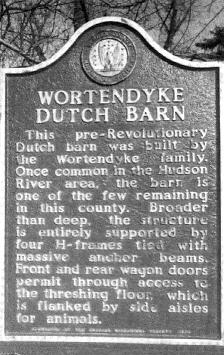 Historical
marker at the barn site. Historical
marker at the barn site.
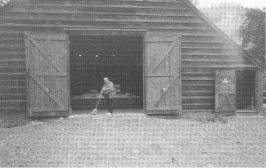
Author standing in wagon door entrance performing
curator duties.
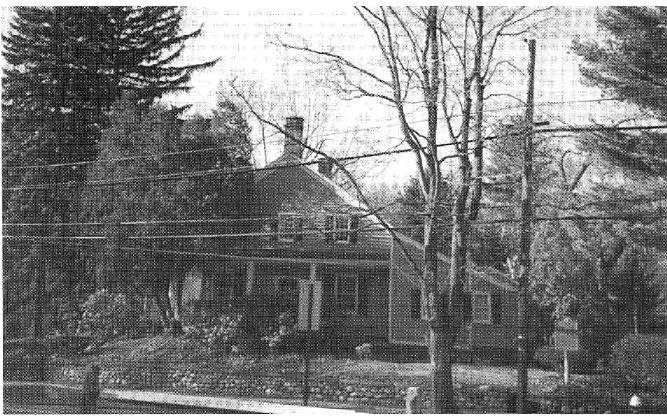
Wortendyke House standing across the street from
Dutch Barn, circa 1750. Roof has been raised and knee wall added
to original red sanstone structure. This house is also a Bergen
County Historic site.
|